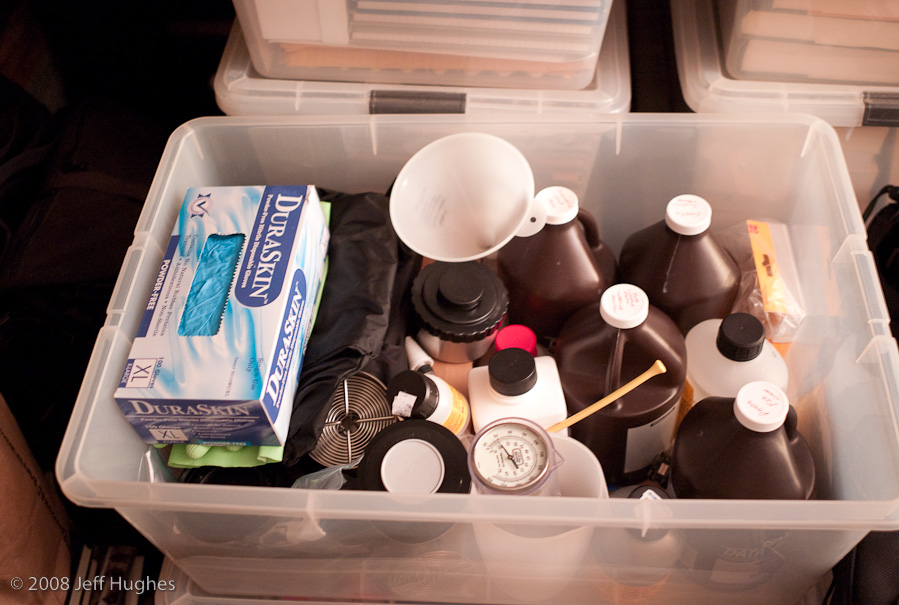
Jeff's Darkroom in a Box
My “darkroom” consists of a changing bag, a couple of stainless steel tanks and reels, a couple of graduates, a thermometer, chemicals, and a couple-foot square plastic box to store everything in. Oh yeah, and the kitchen table.
I was first driven to try doing darkroom work in the early nineties. I had read a couple of articles on Tech Pan, Kodak’s specialty black & white film. The articles promised that the film was so amazingly sharp and fine-grained that I could achieve medium format or even large format quality from my 35mm cameras. So I bought a roll from the local store and spent a day or so shooting it off. I trudged downtown with all my equipment, including a heavy Bogen tripod, and took a bunch of shots. I even got rousted by the Capitol police for using the tripod. (Apparently, a permit is required to use a tripod on the Capitol grounds). In addition to the shots downtown I shot a few scenics around home, including a couple of abstract “tree bark” shots, a la Ansel Adams.
Unfortunately, when I had finished the roll I couldn’t find anyplace which would develop it. None of the local shops I called, even those which otherwise developed or had arrangements to have B&W developed, would take my roll of Technical Pan. Apparently the film, and Technidol – Kodak’s specially-designed developer, were just sufficiently esoteric that no one would touch it. Well, I still wanted my Ansel Adams pictures – already shot, no less – so I looked into doing it myself.
Of course the process and equipment needed for just doing film developing is quite basic. So a few days later, and a trip or two to the camera store, had me outfitted with the aforementioned changing bag, thermometer, and graduates, along with a single-reel tank and the necessary chemicals. I practiced loading the reel a couple times, in the light at first, and then in the dark, with a roll of long-expired film I had on hand. It really wasn’t that hard.
Using my runner’s watch as a timer, that night I developed the film. It was really quite simple. And it was really cool when I unwound the just-developed film off the reel, seeing the “looks ok” negative images, and hanging it from clips to dry. It kind of had a magical feel to it.
The next morning, after it was dry, I cut the film into strips and put them into a glassine envelope. I didn’t have any way to really evaluate them, other than by just looking at them. But by that measure they looked fine. Meaning they looked pretty much like most other commercially-processed B&W negatives I had seen.
Not having any way to make prints, and certainly not being able to afford having all or even many of them enlarged, I took my glassine envelope of film down to the local camera store and asked for a contact sheet. As I recall I paid somewhere around eight dollars for that contact sheet. Seemed like quite a lot of money for the single sheet I received in return. When I got it back I scrutinized it in detail for the “winners”. But despite repeated viewings of that contact sheet, I found the tiny little images not much better than the raw negatives themselves for devining any photographic potential. If there was Ansel Adams quality hidden in any of those images, it was lost on me.
I was disappointed, realizing that I would need to have some sort of control over the second-half (printing) process, in order to make the first-half (film developing) meaningful. My contact sheet and the glassine envelope of once-hopeful Tech Pan exposures went into the closet.
Fast forward a handful of years and by the end of the nineties film scanner and ink jet technologies had matured to a point where they provided that back-end process I needed. I had been scanning slides - long my film preference - since around 1997. In 2001 I decided to once again try my hand at black & white film developing. I dug out that old tank and reel, made a couple trips to the camera store for fresh chemicals and a few other odds and ends, and bought a couple-foot-square plastic storage box to stow everything in. Thus was born my "darkroom in a box".
It actually works pretty well.